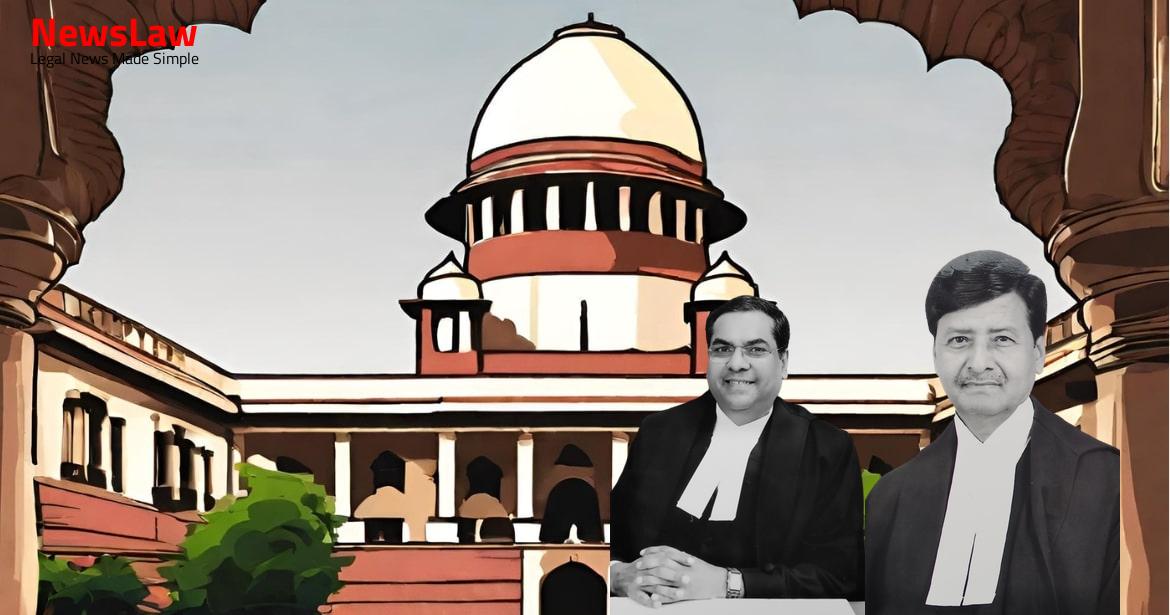Exploring a significant case involving a dispute over land acquisition and compensation in Maharashtra, the Supreme Court of India has delivered a crucial judgment. The case sheds light on the challenges faced by individuals in acquiring fair compensation for their land, especially in the context of development plans and zoning regulations. This summary delves into the details of the legal battle and the court’s ruling on the matter.
Facts
- The State did not challenge the order dated 15.09.2011 regarding rental compensation entitlement from 15.11.1998 to 04.08.2000.
- The State relied on the findings of the Reference Court about the blue colour affecting only a small strip of land and upheld the compensation rate for all claimants.
- High Court confirmed the compensation rates awarded by the LAC, but later ordered a refund of excess compensation withdrawn.
- The High Court determined market value at Rs. 100/- per sq. ft. without amending the pleading for enhanced compensation.
- High Court found the suit land was not suitable for non-agricultural use unlike other surveyed lands and dismissed the appellant’s appeal while allowing the State’s appeal.
- State’s appeal in another case resulted in compensation rate reduction from Rs. 100/- to Rs. 5.30 per sq. ft.
- Various sale deeds were considered by the High Court, rejecting some post-notification transactions and those related to non-agricultural lands without conversion details.
- The High Court affirmed the Reference Court’s findings and noted specific survey numbers converted to non-agricultural use, contrary to the suit land’s status.
- The High Court upheld the rental compensation entitlement as per the enhanced amount but limited the withdrawal to half the awarded amount.
- The appellant contended that the land was in a developed area adjacent to various establishments such as Ramakrishna Vivekanand Vikri Kendra, Maratha Sewa Sangh, Vyankatesh Restaurant, etc.
- The claimant witnesses testified that the land was surrounded by residential houses, societies, sub-markets, and a luxury bus stand.
- Maps and photographs were produced to support the claim that the land was suitable for residential purposes.
- The State’s evidence regarding the land being in a ‘Blue Zone’ was deemed inconclusive by the court.
- Various sale deeds and maps were referenced to argue for higher compensation based on the market value of surrounding lands.
- The Reference Court awarded compensation based on the evidence presented by the claimant owners.
- Disputes regarding the land falling under ‘Blue Zone’ were highlighted as a key issue in the case.
- The physical status of the land and its surroundings played a significant role in determining compensation.
- Various appeals were filed by both the claimants and the State in relation to the compensation awarded.
- The judgment of the Reference Court and the High Court regarding compensation were discussed in detail.
Arguments
- The learned counsel for the appellant argued that the land in question was developed non-agricultural land converted to non-agricultural use in 1983, with surrounding developed areas and access to roads.
- The counsel contested the High Court’s finding regarding the failure to convert the land to non-agricultural use, citing evidence of obtaining a Nazul Plot No and carving out plots with fees paid.
- Argued that sale instances and highest exemplar should have been considered for fair compensation.
- The appellant’s counsel raised objections to the State’s claim of the land being on the riverbank, questioning the map used as evidence and the designation of the ‘Blue Zone’.
- Emphasized discrepancies in the acquisition process, lack of supporting documentation for ‘Blue Zone’ classification, and argued against the deduction of development charges.
- Rebutted the State’s arguments on sale deeds, land potentiality, and the width of the flood wall, presenting evidence to support the claim that the land was outside the no-construction zone.
- The appellant disputes the explanation of the VIDC regarding the dotted lines indicating the curved bank of the river.
- The appellant relied on the Standardized Building Byelaws and Development Control Rules for ‘B’ and ‘C’ Class Municipal Councils of Maharashtra but did not present the original record regarding the fixation of the blue line by the Irrigation Department.
- The State argues that the intra family sale deed executed just before the notification under Section 4 cannot be the basis for the compensation rate awarded.
- The State prayed for restoration of the award passed by the Land Acquisition Officer.
- The State emphasized that the failure of the Town Planning Department to incorporate certain aspects in the Development Plan should not impact the valuation.
- Questions arose regarding the market value of the land of the appellant as on 03.06.1999 and its categorization in the ‘Blue Zone’.
- The extent of the ‘No Construction Zone’ and the market value for land falling within and outside of it were also brought up.
- The appellant argued that only a portion of the land should be considered as falling under the ‘No Development Zone’ based on the laws in place.
- Different arguments were presented regarding the determination of flood marks and the calculations for compensation per sq. ft. based on the land size and related sale deeds.
- Suspicious transactions between related parties in another case (LAC No 183) were also highlighted by the appellant.
Also Read: NIACL vs. Flat Products: Legal Battle Over Depreciation Calculation
Analysis
- The court analyzed various exemplars of sale deeds to determine the market value of the acquired land.
- The court discussed the relevance of statutory regulations and demarcations in determining the potential development of the land.
- The court considered the proximity of the acquired land to prominent institutions and developments in the area.
- The court highlighted the discrepancies in the information provided by different parties regarding the land’s classification and potential use.
- The court emphasized the importance of considering the purpose of acquisition when assessing development charges and market value.
- The court made specific references to documents and evidence presented during the case proceedings to support its analysis.
- The court evaluated the award given by the Reference Court and the High Court, pointing out discrepancies and justifications for modifications in compensation.
- Section 21 of the Act pertains to the Development Plan
- Development Plan must be prepared by every Planning Authority within its jurisdiction
- The Plan should be prepared in accordance with the provisions of a Regional Plan, if one exists
- The Planning Authority must submit the draft Development Plan to the State Government for sanction
- The Development Plan should include a survey, existing land-use map, and proposals for land usage
- Development charges should be deducted only when development activities like laying of roads, drains, sewer lines, parks, etc., are involved.
- Market value determination is based on various economic criteria and the price at which a property changes hands between a willing seller and a willing, but not too anxious buyer, at arm’s length.
- In case of choice between exemplars, it is prudent to accept the value based on the transaction between unrelated parties dealing at arm’s length.
- Small plot prices may not be a safe guide for valuing large tracts of land; however, if the large extent is ripe for building purposes, the valuation based on hypothetical layout could be justifiable.
- Compensation awarded in adjacent villages can be considered if similarity in potentiality is established through evidence.
- Rates of compensation awarded in adjacent villages should not be disregarded if similarity is established based on the given set of facts and evidence.
- The court must award just and fair compensation considering the true market value and other relevant factors, regardless of the owner’s claim.
- The balance must be maintained between the State’s power of eminent domain and the citizen’s right to receive adequate compensation.
- There is no restriction on the amount of compensation that a court can award, as the maximum cap has been omitted and only a minimum cap is in place.
- The Standardized Building Byelaws and Development Control Rules for B and C Class Municipal Councils of Maharashtra were applicable during the relevant time.
- Justice and fairness prevailed over technicalities in various instances.
- State government should not use technicalities to deny citizens the true market value for their acquired land.
- Under the Land Acquisition Act, it is unfair to deprive landholders of their land without paying the true market value.
- State government should act fairly and not use technical pleas to defeat legitimate claims of citizens.
- The Division Bench and the Single Judge should have allowed appellants to pay the deficit court fee and awarded higher compensation determined by them.
- The principle mentioned has been upheld in other cases, including Ashok Kumar and Another vs State of Haryana.
Also Read: State v. Accused: Murder Conviction and Sentencing
Decision
- The enhanced compensation for the plot area created due to division was set at Rs. 25/- per sq. ft.
- The deficit court fee payable by the appellant when compensation is awarded at Rs. 42/- per sq. ft along with other statutory benefits.
- The appellant entitled to rental compensation at 8% of the awarded amount for the period from 15.11.1998 to 04.08.2000.
- Modification required in direction no. 5 in the operative order of the Reference Court.
- High Court confirmed the order of the Reference Court.
- The Civil Appeal allowed, setting aside the impugned judgment dated 18.02.2021 in First Appeal No. 896 of 2016.
- Rental compensation entitlement for the land falling within the no construction zone determined by the Special Land Acquisition Officer in the award.
- Interest on the enhanced amount at 9% for one year from 04.08.2000 and at 15% thereafter till payment of amount in the court.
- Continuation of statutory and other benefits as ordered by the Reference Court.
- Restoration of the award for the land within 15 meters of the defined boundary of the water course.
Case Title: KAZI AKILODDIN Vs. STATE OF MAHARASHTRA (2024 INSC 505)
Case Number: C.A. No.-006776-006777 – 2013



